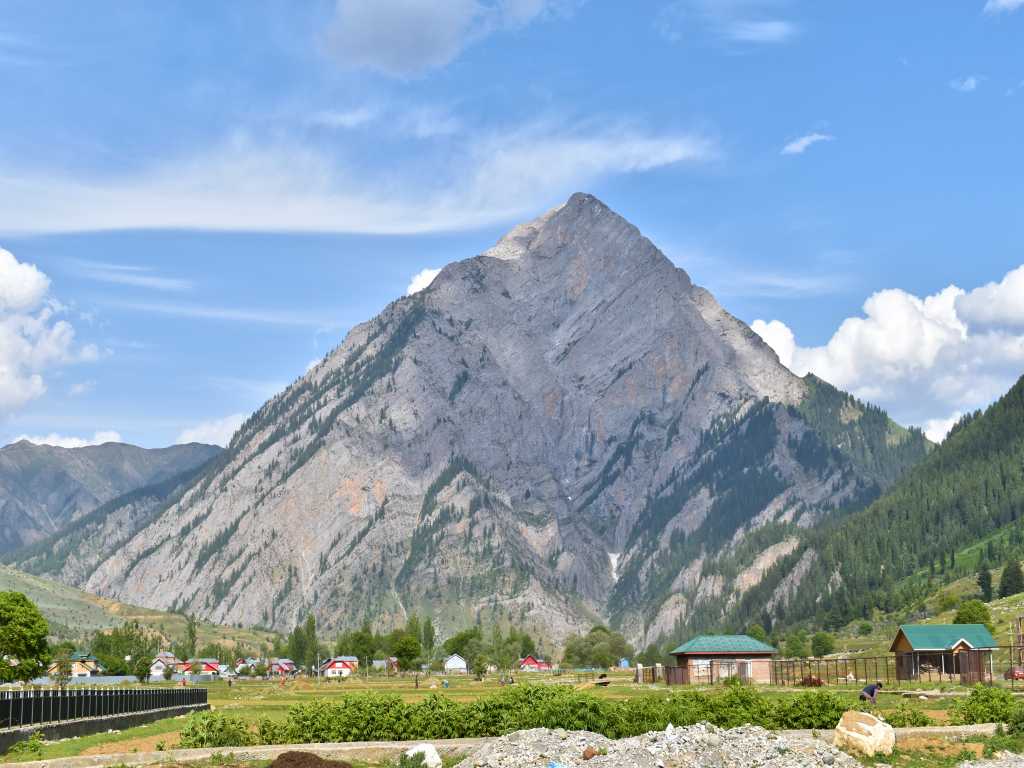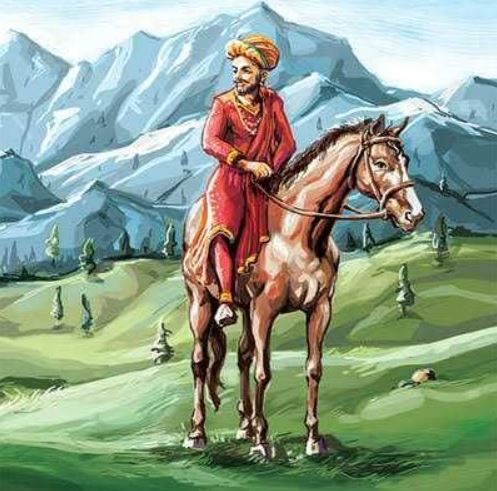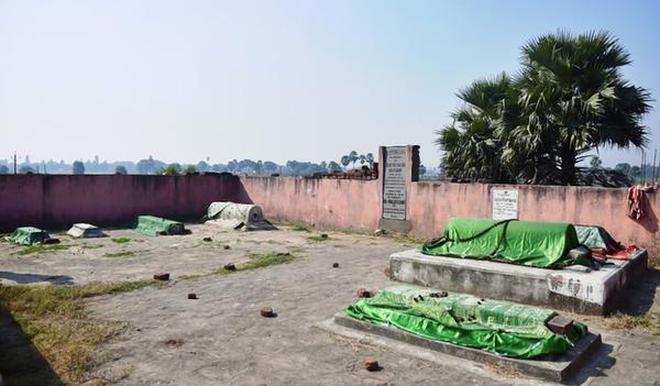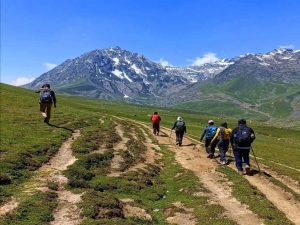
The Golden Pagoda of Arunachal Pradesh – A touch of Thailand in North East India
The Golden Pagoda of Arunachal Pradesh – A touch of Thailand in North East India A shining beacon of Theravada Buddhism in India, the Golden Pagoda of Namsai in the
“The shock of your desertion has come as a blow to me,
O cruel one, I continue to nurse the pain.
Why are you cross with me?
I have not complained even to the spring breeze.
That is my agony.”
The Kishanganga river glides through the picturesque Gurez Valley in North Kashmir until it flows as the Neelum after crossing the border. The river then mingles with the Jhelum near Muzaffarabad in Pakistan. Along the river stands tall a huge facade of rocks confronting the central township of Gurez, Dawar. The pyramid-shaped mountain, around 13000 ft high in stature, is the magnificent Habba Khatoon peak, the star of Gurez valley, Kashmir.
One of the most expensive cumin seeds in the world, known as Gurezi Kala Zeera, is collected by the people of Barnoi from the outskirts of this mountain. To the occasional visitors in Gurez, the mountain is one of many indistinct and grand structures here; to the locals, however, it echoes the incredible and legendary tale of a woman. A woman reiterated only through the vocal remembrance of the verse of loss and the lost quest for love.


Zoon or Zooni was the romantic poetess of the 16th century. Later to be known as Habba Khatoon, she was born to a poor peasant family in Chandhara village in Kashmir’s Pampore on the bank of Jhelum. In the home of Abdi Rather and his wife Janam, ‘The moon’ (‘Zoon’ in Kashmiri translates to ‘moon’) was to be nurtured in love, but the illiteracy at her home did not bode well with her artistic expressions.
She was soon married off to another dark place, to the interior of a carpenter’s household. Husband Aziz Jan and his extended family, the in-laws, took it upon themselves to demean her creative tides, thrashing and throwing her out to a sheep-pen.
In another version of her legend, Zooni was baptized at a budding age by a Sufi mystic, the village moulvi. Zooni grew up to be a beautiful girl and under the light of the majestic Sufi expression, Zooni drove into the creation of a string of poetry and music. Her own compositions as well as her beautiful voice soon made her popular in the surrounding villages. But it was love that truly elevated the brilliance of Kashmir’s greatest poetess.
The land of Kashmir was under the rule of Chaks until 1589 AD, known to be a tribe of fighters from Gurez Valley. They resisted several attacks of the fearsome Mughal Emperors Babar and Humayun and twice the fallen invasions of Akbar.
Speculation brings light to the apparent treachery of a royal subject in Sultan Ali Shah Chak’s courtyard, whose betrayal caused the Sultan to die during a polo match. Yousuf Shah Chak, the last heir and eventually the last independent king of Kashmir, had to be crowned to reinstate the regal decorum.

According to legend, one day Yousuf Shah Chak happened to pass by the village on his horseback where among the chinar trees and the saffron fields of the place, Zooni was immersed in singing her melancholic, soulful verses. The prince heard her sing and fell madly in love with her voice and beauty. It was love at first sight for both of them. It was love that made the emperor stay here longer than intended, and then a little longer.
Folklore has it that the prolonged courtship made the villagers question the sanctity of such a union. This version of the story goes on to say that this is when she was forced to marry a peasant boy and the subsequent abuses. Even then, she refrained from consummating the marriage. She challenged the accusation of adultery, in the face of being forced away by her in-laws.
Firm in her convictions, Zooni appeared with Yousuf to the village court for a hearing, clearing the forged allegations of physical intimacy. Soon they eloped to Gulmarg and got married.

Six years went by; the King spent most of his time in the harem, in the loving company of his wife, who by then became ‘Habba Khatoon’. History was unfolding in the backdrop. After failing twice, Mughal Emperor Akbar, resolved to annex Kashmir to his empire and dealt his last and the most promising card. He invited the Chak King to his court, luring him with an intimation of a peace treaty.
Without much choice and with a fear of another invasion, Yousuf fell onto the cobweb of Akbar’s gamble. As soon as he arrived at the Mughal Durbar, Yousuf Shah Chak was captured and imprisoned. He was flung into prison in Bihar, far away from his beloved queen, never to see the light of day again. His grave still lies there.
The news of his death was passed on to Zooni’s ears. She crossed the threshold of the royal entrance with her daughter on her lap, shivering in a snowstorm, never to return again. It is said that she soon became an ascetic and roamed the valleys of Kashmir, especially the grand pyramid mountain of Gurez Valley, Kashmir. Her sorrow vibrated in nature, against the mountains; the tale of a woman detached in loss and the eternal longing for her husband.
Instead of writing spiritual and community-based poetry, she adopted the more humane and common ground – loss and separation. Her initiation of ‘loal’ in Kashmiri poetry, equivalent to a lyric in the English language, expressed her brief thoughts. She is also credited to create the ‘watsun’, a form of lol lyric that comprises three-line stanzas followed by a refrain. “This form has a long history and tradition in Kashmir. It is rarely more than six to ten lines, including the refrain, and often converges on a single mood.”
During her time at the King’s palace after her marriage, she got the opportunity to develop her musical talents. At a time when Persian was the official language at the royal court, she used the colloquial language of the masses. The native diction and expression of romantic love, loss and separation coupled with the tense and vivid passion of her poetry made a mark at that time in ordinary people’s minds. So much so, that her contribution continues to capture the emotions of the common masses to the present day.

Today, no one knows to be sure where her tomb lies. It is said that she rests with her emperor husband at an obscure cemetery in Biswak village in Bihar’s Nalanda district, while others claim her tomb lies near Athwajan on the Jammu-Srinagar National Highway, 20 km from Srinagar. Both burial grounds are in decrepit negligence surrounded by discolored boundaries, unattended and forgotten.
A day’s journey away from Srinagar in the hidden highlands of North Kashmir, the towering mountain named after her, still stands tall. The giant pyramid serves as a grand reminder of the Legend of Zooni, which is consumed and treasured, even today, by the nostalgia of the elders and the curiosity of the young, by the followers of Kashmiri poetry and lovers of history.
Whatever be the case with her tomb and whether or not it receives the much-needed attention of our heritage protectors, the star mountain of Gurez Valley will hopefully keep standing as a majestic symbol of the poet-queen’s greatness and a cultural icon’s legacy.

To curate your personalized tour of this unexplored wonder in Kashmir, please check this page. If you loved our snowy adventures, consider the Tarsar Marsar Trek for your next adventure! And don’t forget, Kashmir isn’t just about stunning landscapes; it’s a paradise for shoppers too. From luxurious shawls to the finest saffron, there’s something special for everyone to bring home from this enchanting land.

Contributed by our team of experiential travel experts, explorers and storytellers.

The Golden Pagoda of Arunachal Pradesh – A touch of Thailand in North East India A shining beacon of Theravada Buddhism in India, the Golden Pagoda of Namsai in the

James Burke’s Kashmir of 1960: A legendary photojournalist’s journey through the vale Explore Kashmir through the vintage lens of James Burke – the legendary writer, war correspondent and a distinguished

Secrets of the Stones: The Ancient Rock Carvings of Padum Zanskar Valley Amidst the rugged, isolated landscapes of Zanskar Valley, the echoes of ancient prayers still seem to linger in

Suru Valley Ladakh – featured in National Geographic’s ‘Best of the World’ 2025 List Suru Valley in Ladakh is the only destination from India to be featured in National Geographic’s list ‘Best of

Black-Necked Crane – The state bird of ladakh that brings you good luck Black-Necked Crane – rare alpine bird of Ladakh is also a cultural icon in the Trans-Himalayas

The Best hotels in Gangtok Sikkim – unveiling the top Luxury escapes A Guide to the Finest Luxury Hotels in Gangtok, Sikkim – all offering grand views of Mt. Kanchenjunga

The Dev Kyara Trek in Uttarakhand: Best Offbeat Trek in Garhwal A GUIDE TO ONE OF THE LEAST EXPLORED REGIONS OF UTTARAKHAND Trekking in Uttarakhand is a blissful experience

The Hemis Festival: Ladakh’s Grand Cultural Carnival Ladakh is an enchantingly beautiful land steeped in ancient history, mythology and mysticisim. Here, ancient traditions come alive amidst the most rugged yet

Trekking in the Himalayas: Culture, Spirituality & Adventure Himalayas, the world’s most majestic and mystical mountain range, have long beckoned adventurers, nature lovers, and spiritual seekers from all over the